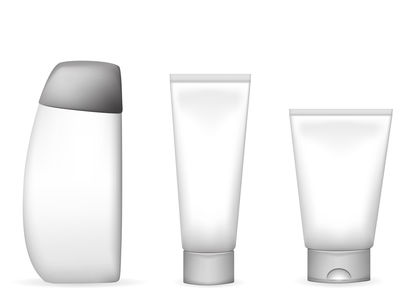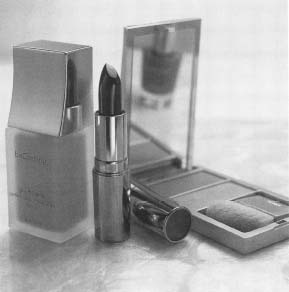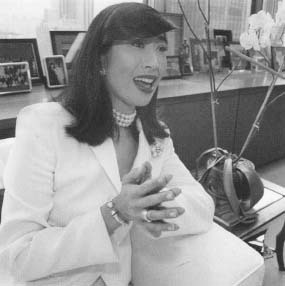Avon Products, Inc.

1345 Avenue of the Americas
New York, NY 10105
(212) 282-5000
www.avoncompany.com
When Avon started operations in 1886 under the name California Perfume Company (CPC), the idea of setting women up in their own businesses was a revolutionary one. Women did not yet have the right to vote and only about 15 percent of them worked outside the home. In less than a century, however, Avon grew into a multibillion-dollar enterprise, and an army of "Avon ladies" selling beauty products door-to-door became a powerful force in the business world.
Salesman Starts Company
David H. McConnell (1858-1937), a twenty-eight-year-old New York salesman, started the California Perfume Company because he felt that women were a vastly under-tapped resource, both as customers and workers. The company's first headquarters was in a 500-square-foot office in New York City where manufacturing, shipping, and administration were handled. McConnell not only developed his own perfume formulas, he was the company's bookkeeper, cashier, secretary, and shipping clerk.
McConnell believed the best way to sell his perfumes was with a door-to-door sales force. In particular, he thought the most successful sales representatives would be women who could walk around their neighborhoods selling cosmetics to friends and family. So, in 1886, he hired Mrs. P. F. Albee, a minister's daughter, to be a CPC sales representative in Winchester, New Hampshire. Mrs. Albee was the world's first Avon lady. Her official title, however, was general traveling agent. Albee not only became a saleswoman, she immediately began recruiting a sales force of housewives. The company's first product was Little Dot Perfume, but the product line quickly expanded to other perfumes, makeup, and bath products.
For the first few years, Avon ladies were limited to rural areas and small towns where they could take advantage of the large social networks they were connected to. McConnell also believed customers were more likely to trust a female neighbor they knew. Most door-to-door sellers at the time were men who typically used glib, high-pressure sales tactics. The Avon ladies' approach was friendlier and more low-key.
McConnell quickly shipped products to his sales representatives, who promptly delivered them to their customers. CPC quickly gained a reputation for a strong sales force, quality products, and dependability. As the company grew, sales representatives were recruited by traveling agents, usually unmarried women who could be on the road for long periods of time. By 1900, the company had forty-eight traveling agents and more than 5,500 door-to-door sales representatives.
Avon at a Glance
- Employees: 39,000
- Sales Representatives: 3.5 million
- CEO: Andrea Jung
- Subsidiaries: Discovery Toys; Avon Products, Ltd. (China); Avon Products Company Ltd. (Japan); Avon Products Manufacturing Inc. (Philippines); Avon Products Pty. Ltd. (Australia); Cosmeticos Avon SACI (Argentina)
- Major Competitors: L'Oreal; Mary Kay; Revlon; Estée Lauder
- Notable Product Lines: Anew; Avon Skin Care; Avon Color; Avon Wellness; Advance Techniques; Skin So Soft; BeComing
McConnell rarely visited his sales force in person. Instead, he kept in frequent touch by mail, usually offering encouragement. He was foremost a businessman, however, and a scolding was given when performance lagged. He also kept in touch through a monthly company newsletter. In one early newsletter he wrote, "Enter upon your work joyously, without fear, and push for the result desired."
Timeline
- 1886:
- David H. McConnell starts the California Perfume Company in New York.
- 1914:
- First overseas office opens in Montreal, Canada.
- 1928:
- First products offered under the Avon brand name.
- 1937:
- McConnell dies and his son, David H. McConnell jr., becomes company president.
- 1939:
- The company changes its name to Avon Products, Inc.
- 1946:
- Avon stock offered for public sale.
- 1954:
- Company launches its "Ding, Dong, Avon Calling" advertising campaign; annual sales are at $55 million.
- 1970:
- Annual U.S. sales reach $750 million; Avon begins selling in Japan and Argentina.
- 1979:
- Global sales hit $3 billion; company stops using environment-damaging CFCs in its aerosol products.
- 1986:
- Avon celebrates its one-hundredth anniversary; invests in magazines and healthcare products.
- 1989:
- Company stops several takeover attempts.
- 1990:
- Avon begins selling in China; ends product testing on animals.
- 1997:
- Annual sales reach $5 billion worldwide; sales force at 2.6 million; Avon launches Web site.
- 1998:
- Avon sets up small sales kiosks in U.S. shopping malls.
- 1999:
- Andrea Jung becomes the company's first female CEO.
- 2001:
- Annual worldwide sales reach $6 billion; global sales force at 3.5 million, including 550,000 in the United States.
- 2002:
- Avon lays off nearly four thousand workers.
Company Expands
California Perfume issued its first product catalog in 1896, which contained descriptions of items but no photographs. In 1897, McConnell had a three-story, 3,000-square-foot laboratory constructed in Suffern, New York, to develop new cosmetic products for the company. In 1906, its first print ads appeared in Good Housekeeping and its first color catalog was issued. Disaster struck that year when CPC's San Francisco office was destroyed in the great earthquake that decimated the city. A new office soon opened, as did new branch offices in Luzerne, Pennsylvania, and Davenport, Iowa. By the end of the year, the company had ten thousand sales representatives and managers, and offered 117 different products.
In 1914, CPC opened a sales office in Montreal, Canada, followed the next year by a manufacturing plant. By 1920, annual sales revenue had topped $1 million. Fueled by the economic boom of the 1920s, annual sales reached $2 million in 1928, powered by twenty-five thousand sales agents in the United States and Canada. The company moved into a new headquarters, a just-built skyscraper in Manhattan. It also introduced its first products under the Avon brand name: a toothbrush, talcum powder, and a vanity set.
McConnell died in 1937 and his son, David Jr., became president of CPC. The company moved its headquarters to a larger building in Rockefeller Center in New York. The company also instituted a money-back guarantee on its products. Despite the economic hardships following the Great Depression (1929-34) when millions of Americans lost their jobs, CPC managed to flourish, doubling its sales revenue to $4 million by 1938.
The Man Behind the Women
Avon founder David McConnell was born on July 18, 1858, near Oswego, New York. His father was a dairy farmer but McConnell had other ambitions. He went to work as a door-to-door book salesman with Union Publishing Company. To entice female customers to buy his books, he gave them a small vial of rose-scented perfume. When he discovered that many women were buying books just to get the perfume, McConnell decided to launch his own perfume company.
Ding Dong, Avon Calling
In 1939, David McConnell Jr. changed the company's name to Avon Products, Inc., in honor of his father's love for playwright and poet William Shakespeare (1564-1616), who was born in Stratford-upon-Avon, England. In 1941, the United States entered World War II (1939-45), and half of Avon's New York manufacturing plant was quickly converted to military use. Avon continued to grow and in 1944 had annual sales of $14 million. That same year, J. A. Ewald took over as president following the death of David McConnell Jr. In 1946, Avon began offering its stock for sale to the public.
Avon continued its growth through the 1950s, opening branch offices in Atlanta, Georgia, and Newark, New Jersey. Its annual sales jumped to $55 million by 1954, and the company now offered more than five hundred products. Avon's success was in part due to its highly successful television advertising campaign, which featured the now-famous "Ding Dong, Avon Calling," slogan.
Avon Goes Global
The 1950s also saw the company's overseas presence expand, with offices opening in Puerto Rico, Venezuela, and Cuba. During the 1960s, Avon opened offices in Mexico, West Germany, Brazil, Great Britain, and Australia. The company's U.S. revenues reached $250 million in 1963 with an additional $33 million coming from overseas sales. By 1970, sales in the United States reached $750 million and the product line had increased to eight hundred items. Internationally, Avon ladies began to sell products in Argentina, Japan, Ireland, France, Italy, and Spain.
Until early in the twentieth century, most sales representatives made their calls on foot, horseback, or horse-drawn carriage. But, just as the California Perfume Company was getting off the ground, the first automobiles were being invented and times began to change for traveling salesmen (and women). In 1911, Effie Miller of Oregon won a new Brush Runabout automobile for being the CPC's number one sales agent.
Sales reach $3 billion by 1979, spurred by expansion into Hong Kong, Thailand, the Ivory Coast, the Philippines, New Zealand, El Salvador, Malaysia, and Chile. The number of sales representatives topped one million worldwide. The company also went on a buying binge, purchasing upscale jeweler Tiffany & Company. It also acquired a chemical manufacturing firm and a health products company.
Decades of growth came to a halt in the 1980s as annual sales declined or remained flat. Avon's purchase of Tiffany's proved to be a bad investment and the company was sold in 1983. Yet Avon continued to diversify, investing in magazines, retirement properties, and catalogs for children and men's wear. By the end of the decade, it had dismantled its health care company at a loss of $520 million and had total debts of $1.2 billion. The late 1980s also saw a series of takeover attempts by companies such as Amway and rival Mary Kay. The takeover attempts failed, but they caused Avon management to begin a company makeover. The biggest strategy was to concentrate on Avon's core line of beauty products. In 1989, a new chief executive officer (CEO), James Preston, was hired to get the company back on track.
Avon rebounded in the 1990s, posting annual sales of $5 billion in 1997, most coming from the company's worldwide sales force of 2.6 million women and men. It also launched its Web site that year, allowing customers to buy products on-line. The move, however, made many of the company's half-million U.S. sales representatives angry. Avon would be able to reach millions of customers directly, allowing sales to take place without salespeople. Sales representatives felt that their established customers would abandon them for the Web. Tensions escalated the following year when Avon set up kiosks, or small stores, in shopping malls around the country.
Avon: For a Good Cause
The 1970s saw the beginning of Avon's jump into charitable work. It sponsors a tennis championship for youth organizations and two marathons for women's groups. It also opened a women's cultural center in Japan. In the environmental arena, Avon stopped using chlorofluorocarbons (CFCs) in its aerosol products. CFCs damage the ozone layer, which surrounds the earth and protects it from the ultraviolet rays of the sun. In 1990, Avon became the first major U.S. cosmetic manufacturer to stop testing its products on animals. In 1993, the company launched its fund-raising Breast Cancer Awareness Crusade. It followed with the Avon Worldwide Fund For Women's Health, which has raised about $10 million a year since 1992.
Women Named to Top Posts
In 1993 and 1994, Preston elevated three women to top management positions. Christina Gold, head of Canadian operations, became president of Avon-North America. Susan Kropf

To help win back the trust of its U.S. sales force, Avon revamped its Web site, linking it to the Web sites of individual sales representatives. An internal study also showed that most of the sales at Avon mall kiosks came from first-time customers. This meant that existing customers were continuing to purchase Avon products from their sales representatives. The emphasis on change gained momentum in 1999 when Jung became CEO, the first woman ever to lead the company.
Jung's goal was to revamp Avon's product line, packaging, marketing, and even its image. She started by revitalizing

Jung was quick to embrace Internet technology while recognizing its limitations. In a 2000 interview with Chief Executive, she commented that the Internet would make doing business easier, but she also acknowledged that "person-to-person selling in cosmetics is very important. Women like to use products that other women say work. The Internet will be a big opportunity, but you can't smell a fragrance there yet."
Twenty-first Century Makeover
Into the twenty-first century, Avon has undergone a makeover that is more than cosmetic. Its products are designed for a younger, hipper, and more diverse customer base. Looking forward, Avon plans to tap into the vast teen market by launching a separate teen division and enlisting teenage girls as sales representatives.
Avon also continues to expand its product line. In addition to makeup and beauty products, the company now offers nutritional supplements, exercise equipment, and "stress management" products. Avon is also, however, a business and remains dollar conscious. In early 2002, the company laid off nearly four thousand workers in the United States, Mexico, and Puerto Rico in a move to increase its profits.
Comment about this article, ask questions, or add new information about this topic: